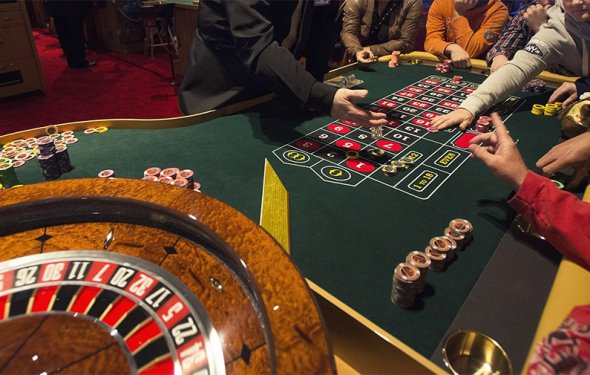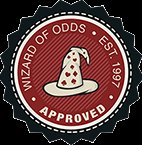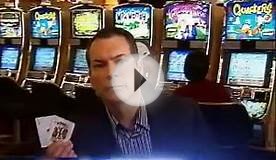Blackjack table odds


Introduction
There are some sources that address the question of the probability of doubling a bankroll before losing it, in a card counting situation. Ken Uston's Million Dollar Blackjack, to name one. This appendix shall not recover that issue. However, I am often asked about how much the basic strategy player's bankroll should be, given a targeted number of hands to play. This is especially practical if the player must play a certain number of hands to earn an online casino bonus.
The rules assumed for these tables are six decks, dealer stands on soft 17, player may double on any two cards, player may double after splitting, player may resplit to three hands, no surrender, dealer peeks for blackjack. Under these rules, the house edge is 0.4140%.
Let's look at an example of how this table can be used. Assume that the player makes a deposit of $1000 to an online casino, and is required to bet through $5000 in action. If the player is to willing to play through 500 hands, then his average bet size would be $5000/500 = $10. The number of betting units would be $1000/$10 = 100. The table shows the risk of ruin is 0.01% for 102 units, so would be just over 0.01% for 100. Perhaps this is too conservative, so the player considers playing 200 hands. The bet size is now $5000/200 = $25. The number of units is $1000/$25 = 40. Interpolating the table shows the risk of ruin would be 1.5%.
Number of Hands to Play
| Risk of Ruin | 100 | 200 | 300 | 400 | 500 | 600 | 700 | 800 | 900 |
|---|---|---|---|---|---|---|---|---|---|
| 50% | 11 | 14 | 16 | 18 | 20 | 22 | 24 | 25 | |
| 40% | 17 | 23 | 27 | 29 | 31 | ||||
| 30% | 12 | 21 | 28 | 33 | 36 | 38 | |||
| 20% | 15 | 26 | 34 | 41 | 44 | 47 | |||
| 10% | 19 | 39 | 48 | 53 | 57 | 60 | |||
| 5% | 32 | 40 | 46 | 52 | 58 | 62 | 67 | 71 | |
| 4% | 42 | 49 | 55 | 65 | 70 | 75 | |||
| 3% | 51 | 64 | 69 | 74 | 79 | ||||
| 2% | 68 | 84 | |||||||
| 1% | 61 | 82 | 88 | 93 | |||||
| 0.5% | 66 | 89 | 95 | 101 | |||||
| 0.25% | 35 | 50 | 80 | 96 | 102 | 109 | |||
| 0.1% | 54 | 77 | 87 | 104 | 111 | 118 | |||
| 0.01% | 45 | 91 | 112 | 122 | 131 | 139 |
| 1000 | 1200 | 1400 | 1600 | 1800 | 2000 | 2500 | 3000 |
|---|---|---|---|---|---|---|---|
| 30 | 37 | ||||||
| 43 | 56 | ||||||
| 73 | 83 | 92 | |||||
| 76 | 105 | 116 | |||||
| 90 | 97 | 110 | 124 | 137 | |||
| 108 | 114 | 129 | 143 | ||||
| 100 | 107 | 121 | 136 | 151 | |||
| 98 | 145 | 161 | |||||
| 99 | 126 | 134 | 142 | 160 | 177 | ||
| 128 | 146 | 154 | 174 | 192 | |||
| 115 | 147 | 156 | 166 | 187 | 206 | ||
| 125 | 138 | 149 | 170 | 180 | 202 | 223 | |
| 148 | 162 | 175 | 188 | 198 | 212 | 236 | 261 |
Methodology
The tables above were created by random simulation. I have been asked several times for a general formula for other situations. Unfortunately there isn't any that I know of. Risk of ruin problems are mathematically usually very complicated. It is easier and more convincing to run a random simulation instead.
- Blackjack online
- avaliação 9 masks of fire
Blackjack Switch is a casino gambling game invented by Geoff Hall and patented in 2009. It is based on blackjack, but differs in that two hands, rather than one, are dealt to each playing position, and the player is initially allowed to exchange ("switch") the top two cards between hands. Natural blackjacks are paid 1:1 instead of the standard...

